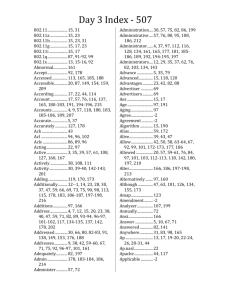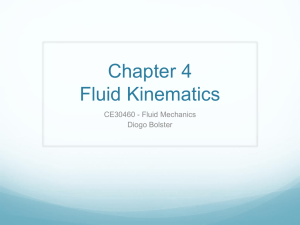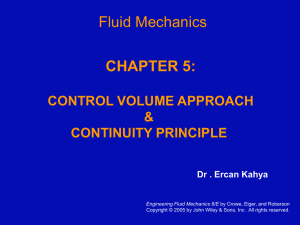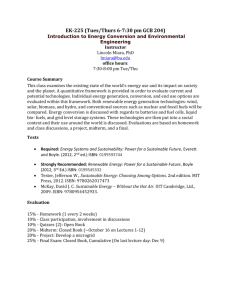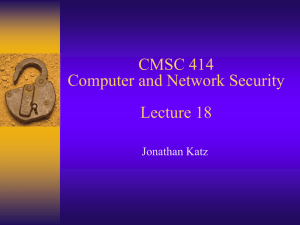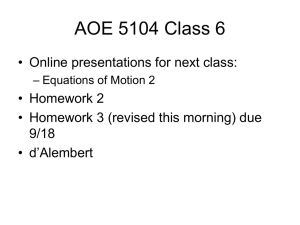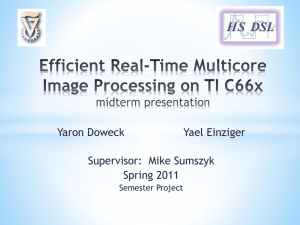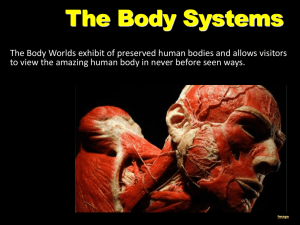Aula Teórica 7
advertisement
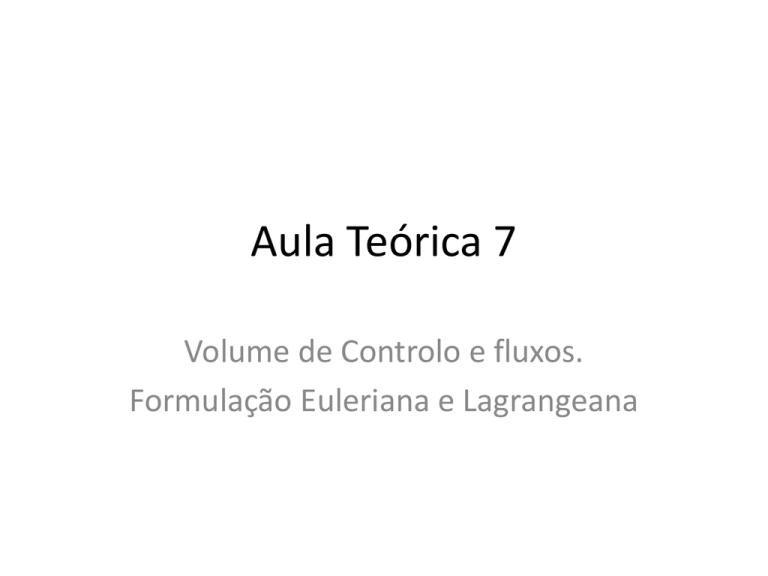
Aula Teórica 7 Volume de Controlo e fluxos. Formulação Euleriana e Lagrangeana Resultant force applied over a volume of fluid yx xy y u y y y dy u y y dy Peso g dxdydz General movement equation du i dt p xi ui 2 x 2 j g i 2 u u ui p i i uj g i 2 t dt x xi x j j du i This equation holds for a material system with a unit of mass. It is written in a Lagrangian Formulation, i.e. one has to follow that portion of fluid in order to describe its velocity. That is not easy for us since we use to be in a fix place observing the flow, i.e. we are in an Eulerian reference . Lagrangian vs Eulerian Descriptions • Both describe time derivatives. • Lagrangian approach describes the rate of change of a property in a material system, i.e. follows material as it moves. • Eulerian describe the rate of change in one point of space. • Lagrangian derivative registers changes independently of velocity. Eulerian registers changes also if fluid moves. • In stationary systems local production balances transport. Case of velocity • • • • • • • Is there acceleration (rate of change of the velocity of a material system)? How do momentum flux change between entrance and exit? If the flow is stationary what is the local velocity change rate? How does momentum inside the control volume change in time? How does pressure vary along the flow? What is the relation between momentum production and the divergence of momentum fluxes? What is the interest of using a lagrangian and an eulerian description? Concentration Fecal Bacteria dies in the environment according to a first order decay, i.e. the number of bacteria that dies per unit of time is proportional to existing bacteria. This process is describe by the equation: dc kc dt C c c0e kt C0 t This is a lagrangian formulation. This solution describes what is happening inside a water mass whether is moving or not. What happens in an Eulerian description? Eulerian description Let’s consider a river where the contaminated water would be moving as a patch (without diffusion) t4 t1 X1 X2 t3 t2 C X1 X2 t Concentration decays as the patch moves. Time series in points x1 and x2 would be: Maximum concentration difference depends on decay rate while difference in time to show up and showing time reduce as flow velocity increases. c t u c x kc Lagrangian vs Eulerian • Examples of videos illustrating the difference between eulerian and lagrangian descriptions (not always very clear) http://www.youtube.com/watch?v=mdN8OOkx2ko&feature=related http://www.youtube.com/watch?v=zk_hPDAEdII&feature=related Reynolds Theorem • The rate of change of a property inside a material system is equal to the rate of change inside the control volume occupied by the fluid plus what is flowing in, minus what is flowing out. d dt dVol sistema d dt dVol VC SC v .n dS Demonstration of Reynolds Theorem Let’s consider a conduct and 3 portions fluid (systems), SYS 1, SYS3 and SYS 3 that are moving. Time = t SYS 1 CV SYS 2 SYS 3 Let’s consider a space control volume (not moving) that at time “t” is completed filled by the fluid SYS 2 Time = t+∆t SYS 1 CV SYS 2 SYS 3 Between time= t and time =(t+∆t) inside the control volume properties changed because some fluid flew in (SYS1) and other flew out (SYS2) and also if properties of those systems have changed. Rates of change B SYS In a material system: B SYS t t t t Inside the control volume: B vc t t B vc t t SYS 2 was coincident with CV at time t: B vc t B SYS 2 t At time t+∆t: B vc t t B SYS 2 t t flowin outflow Computing the budget per unit of time and using the specific property (per unit of volume) B vc t t B vc t t B dB dV dV B SYS 2 t t B SYS 2 t t flowin outflow How much is flowing in and out? adv B v .n dA The volumetric discharge is the integral of the volume flowing per unit of area integrated over the area. The Mass discharge is the integral of the mass flowing per unit of area integrated over the area. The Mass flowing per unit of area is the volume per unit of area times the mass per unit of volume. adv B v .n dA Using flux and specific property definitions integral equations can be written dB dV B dV B vc t t B vc t t dV B SYS 2 t t B SYS 2 t t t t d dt dV t t dV t dV If material is flowing in the internal product is negative and if is flowing out is positive. As a consequence: flowin outflow v .n dA And finally t dV vc d dt dV sistema v .n dA surface Or: d dt dV system t vc dV v .n dA surface If the Volume is infinitesimal dV t d vc dt dV v .n dA system surface Becomes: t V d dt V v .n Aentrance v .n A exit But: d ( V ) dt V d( ) dt d ( V ) dt And thus: x1 x 2 x 3 t x1 x 2 x 3 V d x 2 x 3 v1 x 1 x 2 x 3 v1 x dt 1 x1 x1 x 3 v 2 x 2 x1 x 3 v 2 x 2 21 x1 x 2 v 3 x 3 x1 x 2 v 3 x x 3 3 Dividing by the volume: d( ) dt V x1 x 2 x 3 u k x k u k xk Derivada total t d dt d dt d dt t v k xk v j t x j x j v v j v k x k j x j The Total derivative is the rate of change in a material system (Lagrangian description) ; The Partial derivative is the rate of change in a control volume (eulerian description) ; The advective derivative account for the transport by the velocity.
